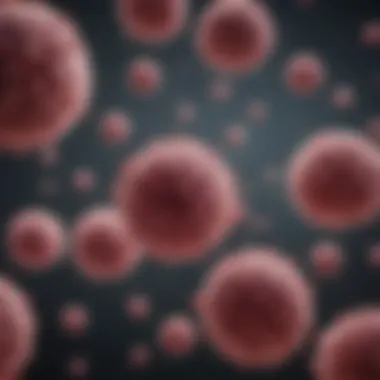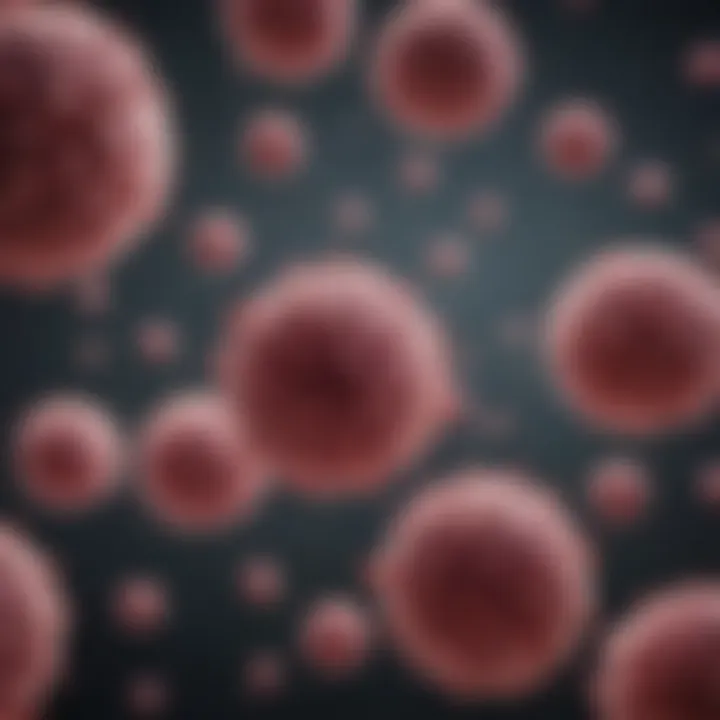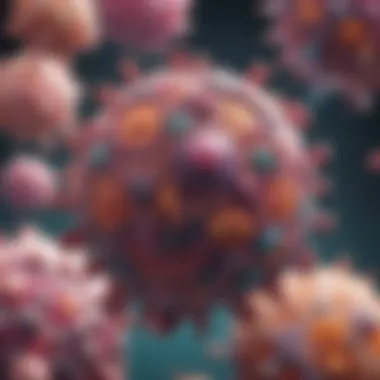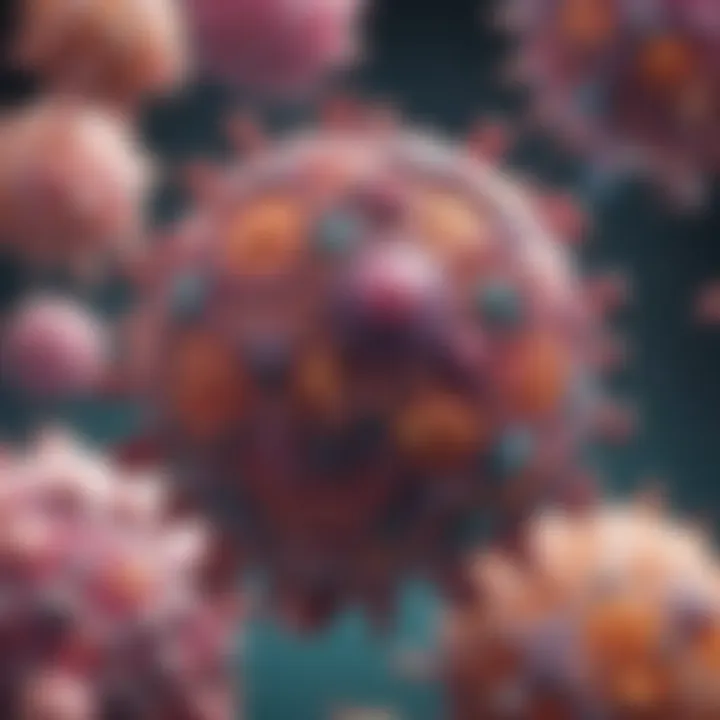Neoplastic Malignancy: Insights into Cancer Biology


Intro
Neoplastic malignancies represent a major challenge in modern medicine and research. Understanding their underlying mechanisms is crucial for developing effective treatments. Cancer impacts millions of people globally, making it a priority for researchers and health professionals. By understanding neoplastic malignancies, from their classification to their biological behaviors, one can appreciate the intricate nature of these diseases.
Current research explores how cancer arises at the molecular level. It investigates how genetic mutations and environmental factors contribute to tumor initiation and progression. With varying types of cancers, each possessing distinct characteristics, it is essential to delve deeper into this complexity.
The exploration of diagnostics and therapeutic approaches is equally significant. Cutting-edge therapies emerge regularly, but many of these options depend on a comprehensive understanding of cancer biology. Therefore, this article endeavors to breakdown the fundamental aspects of neoplastic malignancies, fostering a better grasp among diverse audiences.
Methodology
Overview of Research Methods Used
The research methods employed to understand neoplastic malignancies incorporate both qualitative and quantitative approaches. Researchers utilize clinical studies, laboratory experiments, and statistical analyses to examine various tumor types. This multifaceted strategy enables an extensive exploration of cancer biology and its treatment options.
Additionally, molecular biology techniques, such as next-generation sequencing and gene expression profiling, are crucial. They aid in uncovering the genetic landscapes of tumors, revealing potential targets for therapy. By integrating data from different sources, researchers can build a more comprehensive picture of cancer progression and treatment efficacy.
Data Collection Techniques
Data collection in cancer research involves diverse techniques. These include:
- Patient registries: Gather patients' clinical data to track outcomes and responses to treatments.
- Biopsy analysis: Collect tumor samples for histopathological examination.
- Surveys and questionnaires: Assess lifestyle factors and genetic backgrounds contributing to cancer risk.
- Laboratory assays: Analyze cell lines to understand tumor biology and responses to drugs.
Such data provides essential context for understanding neoplastic malignancies in both laboratory and clinical settings.
Future Directions
Upcoming Trends in Research
Research into neoplastic malignancies is constantly evolving. Some notable trends include:
- Personalized medicine: Tailoring treatments based on an individual’s genetic profile.
- Immunotherapy advancements: Developing new drugs that leverage the immune system to fight cancer.
- Liquid biopsies: Utilizing blood tests to detect cancerous biomarkers for early diagnosis.
These trends reflect a shift towards more individualized approaches in cancer treatment, enhancing patient outcomes.
Areas Requiring Further Investigation
Despite significant progress, several areas remain under-explored. These include:
- The role of tumor microenvironments in cancer progression.
- Long-term effects of therapeutic interventions.
- Mechanisms of drug resistance in various malignancies.
Addressing these gaps will be essential for developing more effective cancer therapies in the future.
Prelims to Neoplastic Malignancy
Neoplastic malignancy represents a critical area of study within cancer biology. Understanding its principles is pivotal for grasping how cancers develop, progress, and respond to treatment. This section aims to illuminate key elements, delineate the importance of recognizing neoplastic conditions, and outline benefits found in a comprehensive understanding of cancer's biological underpinnings.
Definition and Overview
Neoplastic malignancies are characterized by abnormal cellular growth, which may lead to the formation of tumors. These tumors can be classified as benign, which do not spread, or malignant, which have the capacity to invade surrounding tissues and metastasize to distant sites.
Malignant tumors are a product of complex interactions among genetic mutations and environmental factors. According to the American Cancer Society, nearly 40% of individuals will be diagnosed with cancer at some point in their lives. This underscores the necessity for diligent research into oncological phenomena, as it directly relates to public health and personal outcomes.
From a biological perspective, malignancies arise from a series of alterations within the cellular machinery. Oncogenes, tumor suppressor genes, and the aberrations in DNA repair mechanisms frequently play roles in the evolution of malignancies. Grasping these definitions and mechanisms allows for better risk assessment, early detection, and strategic treatment approaches.
Historical Perspectives
The saga of understanding neoplasia spans centuries, with ancient civilizations recognizing tumors as abnormal growths. However, the scientific understanding of these conditions evolved dramatically over time. In the 19th century, pathologist Rudolf Virchow proposed that all cells arise from pre-existing cells, laying a foundation for modern cellular pathology.
Further advancements were made in the early 20th century with the discovery of the role of genetic mutations in cancer by researchers like Theodore Boveri. His work posited the idea that certain chromosomal abnormalities correlate with cancer development, a hypothesis that gained traction as more evidence emerged. The dense interplay between genetics and environmental exposures became increasingly clear with the introduction of the field of molecular biology, especially in the latter half of the 20th century.
As research continues, our understanding of neoplastic biology expands. New methods for detection, such as liquid biopsies, and advancements in targeted therapies show promise for improving outcomes. Therefore, studying the historical perspectives not only illustrates the evolution of cancer science but also emphasizes the continual need for research in understanding and treating this complex set of diseases.
Classification of Neoplastic Malignancies
The classification of neoplastic malignancies is a crucial aspect of understanding cancer biology. It aids in the identification of different tumor types and their behavior. This section outlines the distinctions between benign and malignant tumors, as well as the various subclasses of malignant tumors.
Benign vs. Malignant Tumors
The fundamental difference between benign and malignant tumors lies in their behavior and potential for harm. Benign tumors are typically non-cancerous. They grow slowly and usually do not invade surrounding tissues. Such tumors can often be removed surgically without significant risk of recurrence.
On the other hand, malignant tumors exhibit aggressive characteristics. They can grow rapidly, invade nearby tissues, and metastasize to distant organs. This ability to spread makes malignant tumors a primary concern in cancer care and treatment. Knowing these distinctions is vital for diagnosis and treatment planning.


Types of Malignant Tumors
Understanding the types of malignant tumors offers insights into their unique characteristics and treatment options. Key malignancies include carcinomas, sarcomas, lymphomas, and leukemias.
Carcinomas
Carcinomas are the most prevalent type of cancer. They arise from epithelial cells, which line organs and structures throughout the body. This type includes several subtypes, such as adenocarcinomas and squamous cell carcinomas. A key characteristic of carcinomas is their association with various environmental exposures, including chemical carcinogens, ultraviolet light, and certain viruses. Their high incidence rate makes them a focal point in cancer research. They have the accessibility of various treatment options, but the outcome can vary widely based on stage and location.
Sarcomas
Sarcomas are less common malignancies that originate from connective tissues, such as bone, cartilage, and muscle. The unique feature of sarcomas lies in their diverse histological types and variable behavior. Some sarcomas behave aggressively, while others may grow slowly. This variability presents challenges in diagnosis and treatment. Typically, surgical removal is the primary treatment option, but this depends on the tumor's type and location. Thus, understanding sarcomas contributes significantly to the field of oncology.
Lymphomas
Lymphomas are cancers that affect the lymphatic system. They can be classified mainly into Hodgkin lymphoma and non-Hodgkin lymphoma. An important aspect of lymphomas is their connection to the immune system. Lymphomas can affect immune responses, complicating patient management. Treatment options often include chemotherapy, radiation, and targeted therapies. Their biological behavior can vary widely, making classification critical.
Leukemias
Leukemias pertain to cancers of blood cells, primarily affecting white blood cells. The main types are acute and chronic leukemias, which differ in both onset and progression. A distinguishing characteristic of leukemias is their impact on bone marrow and blood production. The unique feature of these cancers is that they can spread throughout the bloodstream, affecting multiple organs. Treatment may involve chemotherapy, and in some cases, blood transfusions or stem cell transplants. The complexity of leukemias underlines the importance of specific knowledge in clinical settings and ongoing research endeavors.
In summary, the classification of neoplastic malignancies is a fundamental aspect of cancer biology. It provides critical insights into diagnosis, treatment, and understanding the disease mechanism. Recognizing the distinctions among tumor types enhances the effectiveness of oncological practices.
Pathogenesis of Neoplastic Malignancy
Understanding the pathogenesis of neoplastic malignancy is essential in comprehending how cancer develops. This section delves into the specific factors that contribute to cancer, highlighting genetic alterations and environmental influences. Both elements work in concert, driving the complex mechanisms behind tumorigenesis. By examining these factors, we clarify the role they play in the onset and progression of malignancies, which will be helpful in both clinical practices and research.
Genetic Alterations
Genetic alterations serve as a cornerstone in the development of neoplastic malignancies. These changes occur in DNA and can lead to uncontrolled cell growth.
Oncogenes
Oncogenes are mutated forms of normal genes that promote cell division. When these genes become overactive, they can trigger cancerous growth. The key characteristic of oncogenes is their role in cell proliferation. Their importance in this discussion arises from their common presence in many cancers. The unique feature of oncogenes is their ability to drive growth even when cell signaling is low. This makes them particularly insidious. Their advantage in our discussion of pathogenesis lies in their clear association with various cancer types, helping to develop targeted therapies.
Tumor Suppressor Genes
Tumor suppressor genes function to inhibit unwanted cell division. Their role is to maintain normal growth control, and when they are mutated, cancer can result. A defining characteristic of these genes is their capacity to regulate the cell cycle. They are crucial to our topic because their loss of function can lead to neoplasia. A unique aspect of tumor suppressor genes is their "two-hit" hypothesis, meaning both alleles must typically be affected for cancer to occur. This aspect is beneficial as it provides targeted opportunities for therapeutic intervention, but the need for both mutations can complicate detection and management.
DNA Repair Mechanisms
DNA repair mechanisms are vital for maintaining genomic integrity. These systems correct errors during DNA replication and repair damage from environmental influences. Their importance lies in their ability to prevent the accumulation of mutations that could lead to cancer. A key feature of these mechanisms is their multifaceted nature; they involve several genes and pathways. Highlighting DNA repair mechanisms in this discussion emphasizes prevention. Should these pathways fail, their disadvantage becomes stark, as failing to repair DNA leads to further mutations and increased cancer risk.
Environmental Factors
Environmental factors also significantly contribute to the pathogenesis of neoplastic malignancies. They may initiate or promote cancers by interacting with genetic predispositions. Understanding these factors is crucial for prevention and risk assessment.
Carcinogens
Carcinogens are substances that can cause cancer by inducing genetic mutations. A prime characteristic of carcinogens includes their ability to damage cellular DNA. Their inclusion in this article is vital, given their established links to various cancer types. Unique to carcinogens is their diverse nature; they can be chemicals, radiation, or biological agents. While they serve as a warning for public health, the advantage of studying carcinogens lies in their potential for being targeted in prevention protocols.
Radiation Exposure
Radiation exposure is a well-documented risk factor for numerous cancers. It can cause direct DNA damage, leading to genetic alterations. A notable characteristic of radiation exposure is its ability to affect any tissue. This broad impact makes it a crucial discussion point. The unique feature of radiation is its potential for both immediate and delayed effects. This delay can complicate both diagnosis and treatment, underscoring the complexity of cancer pathogenesis in relation to environmental factors.
Infectious Agents
Infectious agents, including certain viruses and bacteria, have been linked to specific cancers. These agents can alter cellular pathways, leading to malignancy. A defining characteristic of infectious agents is their ability to integrate into host genomes. This genetic integration can promote tumorigenesis, which is why we address them in this narrative. Their uniqueness comes from the potential for prevention through vaccination and public health strategies. This preventive aspect is advantageous in reducing cancer incidence linked to infections, but reliance on timely public health measures presents challenges.
Understanding both genetic and environmental factors in cancer development aids in developing effective prevention and treatment strategies.
Molecular Mechanisms in Cancer Development
Understanding the molecular mechanisms that underpin cancer development is crucial for grasping the complexities of neoplastic malignancies. This knowledge informs everything from diagnosis to treatment strategies. Cancer is not a single disease but rather a collection of diseases characterized by uncontrolled cell growth. Key molecular events drive this aberration, which includes cell cycle dysregulation, failure of apoptosis, and the influence of the tumor microenvironment. Each of these areas plays a significant role in the initiation and progression of cancer, presenting new opportunities for therapeutic interventions and improving patient outcomes.
Cell Cycle Regulation
Cell cycle regulation is integral to maintaining normal cellular functions and tissue homeostasis. The cell cycle consists of several phases: G1, S, G2, and M. Critical checkpoints exist between these phases to ensure cells only duplicate when conditions are appropriate. Disruptions in this regulation often arise due to mutations in genes responsible for controlling the cycle. For instance, mutations in TP53, a tumor suppressor gene, can lead to uncontrolled proliferation.
Additionally, cyclins and their associated cyclin-dependent kinases (CDKs) regulate these processes. Targeting these regulators is a promising strategy in cancer therapy, as restoring proper cell cycle control can inhibit tumor growth effectively.
Apoptosis and Cancer
Apoptosis, or programmed cell death, is a natural mechanism that eliminates damaged or unnecessary cells. In cancer, this process is often impaired, allowing abnormal cells to survive and proliferate. Tumors may hijack the apoptotic pathways through upregulation of anti-apoptotic proteins such as BCL-2, or downregulation of pro-apoptotic factors.


Developing therapies that can reactivate apoptotic pathways has been a focal point in current cancer research. For instance, smac mimetics are designed to block the inhibitors of apoptosis proteins (IAPs), thereby promoting cell death in cancer cells. Effectively targeting apoptosis pathways could lead to more successful treatments and better prognoses for patients.
Tumor Microenvironment
The tumor microenvironment (TME) comprises not just the cancer cells themselves but also the surrounding stromal cells, immune cells, signaling molecules, and extracellular matrix. This complex ecosystem plays a crucial role in cancer progression. Cancer cells interact with the TME to promote their own survival and growth.
For example, tumors can recruit immune cells, creating an environment that supports tumor growth and protects it from immune detection. Cytokines secreted by both cancer and stromal cells can enhance tumor proliferation and metastasis. Understanding these interactions leads to potential therapeutic strategies, such as immune checkpoint inhibitors, which aim to restore the immune system's ability to target cancer cells.
"The interplay between cancer cells and the tumor microenvironment is a critical area of research with significant implications for treatment strategies."
By comprehensively examining the molecular mechanisms in cancer development, we can tailor more effective treatments and improve the overall understanding of cancer biology. This insight is vital for both current research and future innovations in oncology.
Clinical Implications of Neoplastic Malignancy
Understanding the clinical implications of neoplastic malignancy is crucial in the realm of oncology. This section delves into the assessments, treatments, and overall management strategies that arise from the complex nature of cancer. The implications are not only surgical or therapeutic but also involve diagnostics and interactions with patients. Effective management depends heavily on accurate diagnostics and a solid understanding of cancer's staging and grading.
Diagnostic Approaches
Imaging Techniques
Imaging techniques play a vital role in the diagnostic process of neoplastic malignancies. These methods, including magnetic resonance imaging (MRI), computed tomography (CT), and positron emission tomography (PET), help in visualizing tumors' presence and nature. The key characteristic of imaging techniques is their ability to provide detailed images of internal structures, making it easier for medical professionals to identify abnormalities. Given their non-invasiveness, imaging techniques are often a first-line approach in diagnosing cancer.
The unique feature of these techniques is their capacity to provide real-time views of the tumor’s size, shape, and location. This objective visualization is vital for clinicians to devise a precise treatment plan. However, disadvantages do exist: exposure to radiation in some modalities, along with potential misinterpretations of results, can complicate the diagnostic journey.
Biopsy and Histopathology
Biopsy and histopathology are essential for definitive cancer diagnosis and understanding tumor characteristics. A biopsy involves the extraction of tissue samples from suspicious lesions, which are then analyzed histologically. The key characteristic of this approach is direct examination of the cancerous cells, allowing pathologists to offer precise information about tumor type and aggressiveness. This makes biopsy and histopathology popular choices for diagnosis in this field.
A unique feature of histopathological analysis is its ability to inform staging and grading processes by assessing cell differentiation and tumor architecture. While biopsy provides essential information, its disadvantages include invasive procedures, patient discomfort, and potential complications. Despite these drawbacks, it remains an indispensable tool in cancer diagnostics.
Staging and Grading of Cancer
Staging and grading of neoplastic malignancies are critical components in determining a patient's prognosis and treatment options. Staging refers to the extent of disease spread at diagnosis, often described using the TNM system - Tumor size, Node involvement, and Metastasis. Grading, by contrast, assesses the aggressiveness of the cancer, typically based on cell characteristics observed under a microscope.
Accurate staging and grading are essential for guiding treatment planning and predicting outcomes. They provide insight into potential response to therapies and help identify suitable treatment modalities. Moreover, they establish a common language for communication among healthcare providers, enhancing collaborative efforts. With advances in imaging and computational techniques, staging and grading systems continue to evolve, offering improved precision in cancer care.
Treatment Strategies for Neoplastic Malignancy
Understanding treatment strategies for neoplastic malignancies is crucial in oncology. Such strategies aim to eliminate or control cancer, improve patient quality of life, and enhance survival rates. The effectiveness of these treatments often depends on type of cancer, its stage, and individual patient factors. This section elaborates on the primary treatment modalities used in managing cancer, their mechanisms, side effects, and the evolving landscape of cancer therapy.
Surgical Interventions
Surgical intervention represents a fundamental approach in cancer treatment. It involves removing tumor tissue along with surrounding healthy tissue to ensure no malignant cells remain. Surgery can be curative, especially in early-stage cancers, as it directly removes the source of the malignancy. Besides curative purposes, surgery also serves diagnostic roles, such as obtaining tissue samples for biopsies. However, surgical intervention is not without challenges. The location of the tumor, potential spread to adjacent organs, and the surgical risks must be carefully evaluated.
Radiation Therapy
Radiation therapy applies high-energy particles or waves to destroy cancer cells. Typically, this treatment is useful for localized tumors. Radiation can effectively shrink tumors or eliminate remnants after surgical procedures. Although it can be impactful, it also poses risks of damaging normal tissues, leading to side effects such as fatigue and skin irritation. Thus, careful planning and precise targeting during treatment are necessary to maximize benefits while minimizing harm.
Chemotherapy and Targeted Therapies
Chemotherapy employs chemical agents to inhibit cancer cell growth and division. It can be prescribed alone or in conjunction with other treatments such as surgery and radiation. The agents are systemic, affecting not just tumors but also rapidly dividing normal cells. This leads to a range of adverse effects but, overall, effectively impacts many cancer types.
Mechanisms of Action
Chemotherapy's mechanisms of action are diverse and allow targeting various cellular processes that contribute to cancer growth. Agents may interfere with DNA replication or repair, inhibit mitosis, or induce apoptosis. The significance of understanding these mechanisms lies in their direct influence on drug choice and treatment design. For example, certain agents target specific pathways altered in various cancers, which can lead to improved outcomes. Developing targeted therapies further refines this approach, as they can directly interact with molecules involved in tumor growth.
Side Effects and Management
The side effects of chemotherapy are numerous and can range from nausea and hair loss to more severe complications such as immunosuppression. Managing these side effects is essential to maintaining patient comfort and compliance. Supportive care, including anti-emetics for nausea and medications to manage infections, can significantly improve overall patient experience. A tailored approach to therapy, considering individual patient circumstances, can enhance effectiveness while mitigating negative outcomes.
Immunotherapy
Immunotherapy is paving new pathways in cancer treatment, employing the body's immune system to target malignant cells. This method has shown encouraging results across various cancers and is tailored to harness specific immune responses.
Checkpoint Inhibitors
Checkpoint inhibitors are a type of immunotherapy that block proteins, preventing cancer cells from evading immune detection. These therapies have revolutionized treatment for some cancers, like melanoma and lung cancer. Their effectiveness hinges on enhancing the immune system's innate ability to recognize and destroy cancer cells. However, they may also lead the immune system to attack healthy tissues, resulting in autoimmune-like side effects, so careful monitoring is necessary.
CAR T-cell Therapy
CAR T-cell therapy is an innovative form of immunotherapy where a patient's T-cells are modified to better equip them to attack cancer. This individualized approach provides promising results, particularly in hematological malignancies. While effective, the method can lead to severe side effects, such as cytokine release syndrome, which can be life-threatening. Understanding and managing these adverse effects is a critical component of this therapy’s implementation, necessitating specialized clinical oversight.
"The evolution of treatment strategies in neoplastic malignancies emphasizes not only the need for individualized care but also the dynamic nature of oncological therapy."


Challenges in Cancer Treatment
In the realm of oncology, the nuances of treating cancer present significant hurdles. Comprehending these challenges aids in enhancing treatment protocols and designing better patient-centric approaches. The intricate nature of cancer demands careful consideration of multiple factors.
One primary issue is therapeutic resistance. This phenomenon occurs when cancer cells evade the effects of treatments designed to kill or inhibit their growth. Such resistance can arise from genetic mutations, alterations in drug metabolism, or adaptive changes in tumor biology. The presence of resistant cells leads to treatment failure and disease progression. Understanding the mechanisms behind this resistance is critical for developing effective therapies. Addressing these resistant populations could help in tailoring treatment strategies that are more effective over time.
Moreover, therapeutic resistance is not solely a biological issue. It intertwines with pharmacogenomics to identify which patients are more likely to benefit from specific therapies. Recent studies indicate that combination therapies may enhance effectiveness against resistant tumors. Therefore, it is crucial to promote ongoing research that identifies novel targets and combinations of treatments.
Another pressing concern is patient compliance and quality of life. Compliance can be significantly influenced by the side effects of cancer treatments. Many patients experience fatigue, nausea, and cognitive impairments, which can deter them from completing treatment. This scenario presents a dual challenge: the need for effective cancer therapy and maintaining the patient's overall well-being. Solutions include supportive care measures and patient education on managing side effects.
Additionally, quality of life encompasses psychological aspects, including anxiety related to treatment outcomes. Mental health support and counseling often become essential components in the overall treatment plan. Addressing these non-medical factors can significantly impact patient adherence to treatment protocols.
Quote: "Effective cancer treatment is as much about managing the side effects and enhancing quality of life as it is about targeting tumor cells."
In summary, the challenges in cancer treatment are multifaceted. This requires not only a focus on tumor biology but also a comprehensive understanding of patient factors that affect treatment success. Advances in research and improved patient management strategies are necessary to overcome these obstacles, fostering a cohesive and effective approach to cancer treatment.
Current Research in Neoplastic Malignancy
Research in neoplastic malignancy is essential for advancing our understanding of cancer and improving patient outcomes. The field is constantly evolving, with new findings reshaping treatment paradigms and diagnostic methodologies. Current studies mainly focus on the identification of novel therapies and preventive strategies aimed at reducing cancer incidence and improving survival rates. This section will delve into emerging therapies and preventive strategies that represent significant advancements in oncology.
Emerging Therapies
Emerging therapies in cancer research are promising and varied. These therapies come from a broad spectrum of scientific inquiries, including immunotherapy, targeted therapy, and gene therapy. Understanding these methods is vital because they target unique aspects of cancer cells, leading to more effective and specific treatments.
- Immunotherapy exploits the body's immune system to fight cancer. Treatments like checkpoint inhibitors, which block proteins that prevent the immune system from attacking cancer cells, show significant results in melanoma and lung cancer.
- Targeted therapy focuses on specific genetic alterations in tumors. For example, therapies targeting the mutations in the epidermal growth factor receptor (EGFR) have been effective for non-small cell lung cancer patients.
- Gene therapy seeks to correct genetic defects or implement new genetic material to inhibit the growth of neoplastic cells. The use of CRISPR technology, for instance, opens avenues for precise alterations in the genome, providing hope for personalized treatment approaches.
The continual exploration of these therapies and their combinations is crucial for understanding how they can be integrated into existing treatment schemes. This research holds the potential to transform neoplastic malignancy management significantly.
Preventive Strategies
Preventive strategies are critical in reducing the overall burden of cancer. These approaches aim at minimizing risk factors through various means, including behavior changes, vaccination, and early detection.
- Behavior modification is a straightforward yet powerful strategy. Educating the public about lifestyle choices—such as avoiding tobacco, maintaining a healthy weight, and engaging in regular physical activity—can decrease the incidence of many cancers.
- Vaccination against certain viruses, like the human papillomavirus (HPV) and hepatitis B virus (HBV), is an effective preventive measure for specific cancer types. For example, the HPV vaccine helps prevent cervical cancer and some other head and neck cancers.
- Screening programs play a crucial role in early detection. Strategies like mammography for breast cancer and colonoscopies for colorectal cancer have shown to reduce mortality rates significantly when cancers are caught early.
Incorporating these preventive measures into public health policies is considered essential for decreasing neoplastic malignancy incidence. Overall, the combination of emerging therapies and effective prevention strategies showcases the proactive stance researchers and healthcare professionals are taking in the fight against cancer.
Ongoing research continually redefines our understanding and approach to neoplastic malignancies, fostering a commitment to innovation in cancer treatment and prevention.
Future Directions in Cancer Research
The landscape of cancer research is rapidly evolving, driven by technological advancements and an increasing understanding of tumor biology. Future directions in this field hold promise for significant improvements in cancer diagnosis, treatment, and prevention. This section will explore two pivotal areas shaping the future: genomics and precision medicine, alongside integrative approaches to cancer care. Both facets are crucial for developing targeted therapies that enhance patient outcomes while minimizing adverse effects.
Genomics and Precision Medicine
Genomics plays a critical role in the evolution of cancer research. By analyzing the genetic makeup of tumors, researchers gain insights into mutations that drive cancer development.
Precision medicine focuses on tailoring treatment based on individual genetic profiles. This approach moves away from the traditional one-size-fits-all model. It enables clinicians to choose therapies that align with a patient's specific genetic alterations.
- Key Benefits:
- Enhanced effectiveness of therapies.
- Reduced risk of side effects.
- Greater potential for early detection via genetic screening.
Moreover, the integration of comprehensive genomic data with clinical information can streamline the identification of potential therapeutic targets. Ongoing projects, such as The Cancer Genome Atlas, continue to catalog the genetic anomalies present in various cancers.
"The promise of genomics lies in its potential to reveal why specific treatments work for certain patients while failing for others."
Integrative Approaches to Cancer Care
Integrative approaches to cancer care emphasize combining conventional treatments with complementary therapies. This methodology addresses the physical, emotional, and psychological needs of patients. It is a shift toward holistic care, acknowledging that managing cancer requires more than just treating the disease.
- Components of Integrative Approaches:
- Nutritional support tailored to patient needs.
- Psychological counseling to assist with mental hurdles.
- Physical therapy to improve quality of life.
- Mind-body practices that reduce stress and enhance well-being.
The synergy of these elements not only improves overall patient satisfaction but has also shown potential to enhance therapeutic effectiveness. Researchers are increasingly studying how these integrative methods can work in conjunction with standard cancer treatments.
Through ongoing exploration of these avenues, we aim to ensure that progress in cancer research translates into real-world benefits for patients.
Ending
The conclusion serves as a vital summarization of the diverse dimensions of neoplastic malignancy discussed throughout the article. It is not merely a restatement of previous sections but an insightful synthesis that reinforces the significance of understanding cancer biology. By encapsulating the intricate pathways involved in tumor development, classification, treatment modalities, and ongoing research, the conclusion highlights the critical link between scientific inquiry and clinical practice.
In this exploration, we recognize that comprehending the complexities of cancer is paramount for various stakeholders. For students and researchers, it lays the groundwork for future studies and innovative approaches in oncology. For healthcare professionals, the insights provided here may support informed clinical decisions, enabling better patient outcomes.
Moreover, the conclusion brings attention to the evolving nature of cancer research and treatment. The rapidly advancing field has opened new avenues for targeted therapies and personalized medicine. Therefore, it emphasizes the need for continuous education and awareness about cancer, irrespective of one’s background.
"Understanding the intricacies of cancer biology equips us to tackle the challenges presented by malignancies effectively."
In sum, a thorough understanding of neoplastic malignancy not only contributes to scientific knowledge but also enhances the ability to confront the myriad challenges posed by various forms of cancer. As we navigate this complex terrain, the pursuit of knowledge becomes integral to advancing the fight against cancer.







